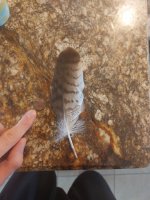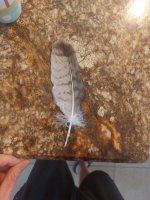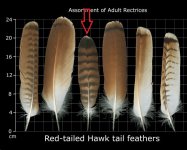How are you, beautiful people of the birb forums 
I am trying to figure out who is the fella that dropped this feather on my front yard. I love picking up feathers from wild doves and other birds and save them as a spiritual souvenirs, and I feed birds on my backyard all the time. Birds really love croissants from Costco by the way, give it a shot, haha! Every bird loves those croissants.
Here is the feather, and a penny for size understanding.
Is that an owl? Maybe a hawk?
Our Phoenix, Arizona owls are grey mostly, and I thought hawks will have different type of feathers, but it does match the color of them.
Any ideas?
Would love to hear the theories.
I live in Phoenix, AZ, we do have a lot of migrant birds, and even saw couple of parents that had a family together.
We have a lot of exotic migrating birds in odd times of the year. As they leave colder regions.
Thank you!
I am trying to figure out who is the fella that dropped this feather on my front yard. I love picking up feathers from wild doves and other birds and save them as a spiritual souvenirs, and I feed birds on my backyard all the time. Birds really love croissants from Costco by the way, give it a shot, haha! Every bird loves those croissants.
Here is the feather, and a penny for size understanding.
Is that an owl? Maybe a hawk?
Our Phoenix, Arizona owls are grey mostly, and I thought hawks will have different type of feathers, but it does match the color of them.
Any ideas?
Would love to hear the theories.
I live in Phoenix, AZ, we do have a lot of migrant birds, and even saw couple of parents that had a family together.
We have a lot of exotic migrating birds in odd times of the year. As they leave colder regions.
Thank you!








